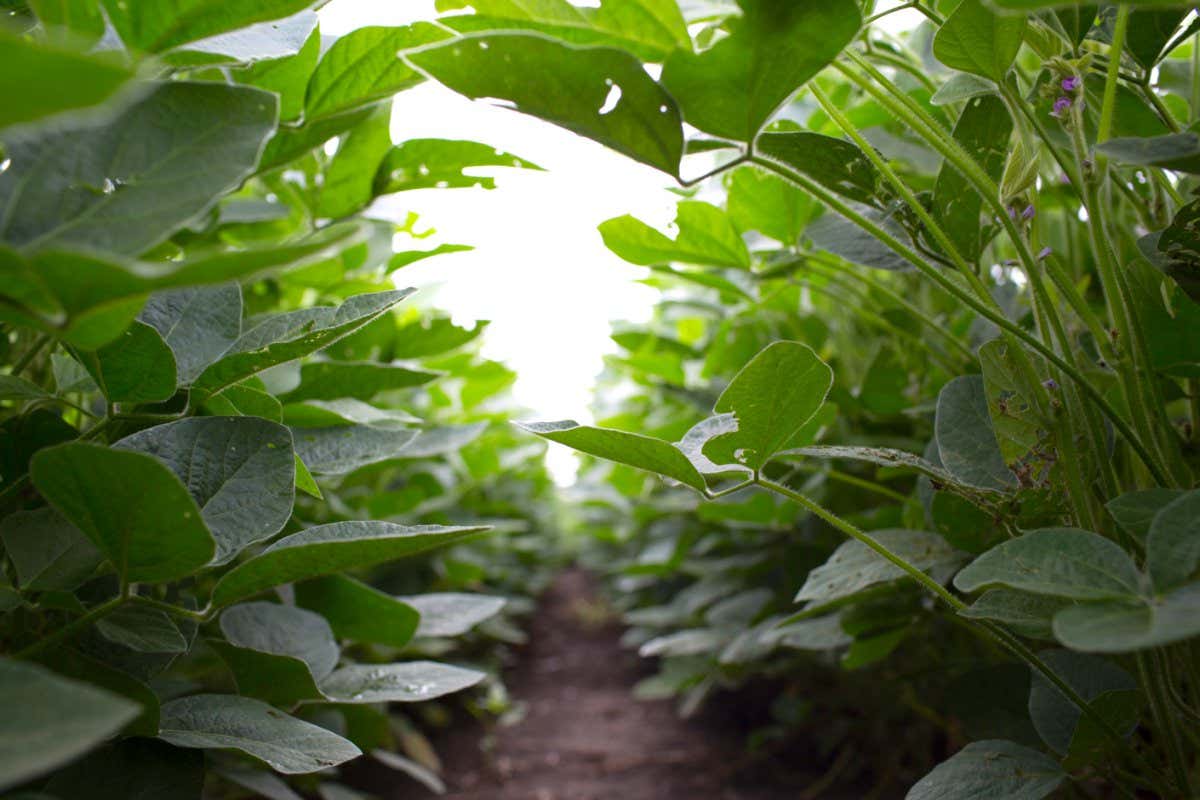Researchers have succeeded in making photosynthesis more efficient in soybean plants, in a major breakthrough that will mean less forest has to be cut down to make way for farms
Environment 18 August 2022
Soybean plants grown in the trial
Haley Ahlers/RIPE Project
Soybeans that have been genetically modified to make them more efficient at photosynthesis have produced yields more than 20 per cent larger than those of unmodified crops in field trials – and with no added fertiliser. Growing these upgraded crops will help reduce deforestation, greenhouse emissions and the loss of biodiversity, as well as increasing the incomes of farmers in low-income countries for whom the crops are being created.
“We think it will work in most crops,” says Stephen Long at the University of Illinois Urbana-Champaign. “We are working on cowpea and we are working on rice.”
Several teams have managed to boost growth in plants such as tobacco by upgrading photosynthesis, but this is the first time it has been achieved in a food plant in field trials, says Long.
Advertisement
The work is the result of a global collaboration set up 10 years ago, mainly funded by the Bill & Melinda Gates Foundation, that aims to boost yields by improving photosynthesis and to make these upgraded crops available to small farmers in sub-Saharan Africa. Several approaches are being explored and combining them should produce even bigger yield increases.
“We think we could get a boost as big as 50 per cent,” says Long. “If that could be achieved, it would be Green Revolution level.” The Green Revolution refers to the major yield improvements achieved in the 1950s and 1960s thanks to improved crop varieties and other technologies.
The genetically modified soybeans have higher yields because they adapt better to changes from sun to shade, and vice versa. When a leaf is in full sunshine, it absorbs more light energy than its photosynthetic machinery can handle. This damages cells unless they turn on a mechanism known as quenching to dissipate the excess energy.
When a leaf is shaded, however, quenching has to be turned off to avoid dissipating energy that could be used. Most crop plants turn quenching on and off rather slowly, and lose a lot of energy as a result.
It isn’t certain why this is, says Long, but it could be because the wild ancestors of many crops grew in semi-arid conditions with few plants close to them. Now they are grown very closely together, and as the sun moves through the sky, most leaves continually have the shadows of other leaves moving over them.
Some wild plants, such as ferns, do turn quenching on or off much more rapidly, says Long. His team has added extra copies of three genes involved in the quenching process to the soybeans, which results in higher levels of the encoded proteins and speeds up the transitions, making photosynthesis more efficient.
“Although we don’t fertilise our soybean crops, the protein content was unchanged,” says Long. That is important, given soya is the main plant source of protein globally.
“This study is very exciting,” says Emma Kovak at the Breakthrough Institute, a global research centre.
Agriculture is responsible for a third of all greenhouse gas emissions, with a quarter due to the clearance of land, she says. “Not only do yield increases help reduce greenhouse gas emissions, but by reducing deforestation, they also help preserve plant biodiversity and wildlife habitat.”
In the US alone, a 15 per cent yield increase in soybean crops would reduce greenhouse gas emissions by an amount equivalent to 100 million tonnes of carbon dioxide, Kovak has previously estimated.
“A major effort is needed to improve crops because the annual yield gains for our major crops have plateaued, the world population is growing and we have climate change,” says Christine Raines at the University of Essex in the UK, whose team is working on another way to boost photosynthesis.
“We also need to increase yield in a sustainable manner, for example without the use of additional nitrogen as was shown in this current study,” says Raines.
Most other crops can’t make their own nitrogen fertiliser in the way that legumes like soya and cowpea can, and so might need extra fertiliser to take advantage of photosynthesis upgrades. But the Gates Foundation is also funding work to add the ability to fix nitrogen to other crops, which would also have huge environmental benefits.
Journal reference: Science, DOI: 10.1126/science.adc9831
More on these topics:
































